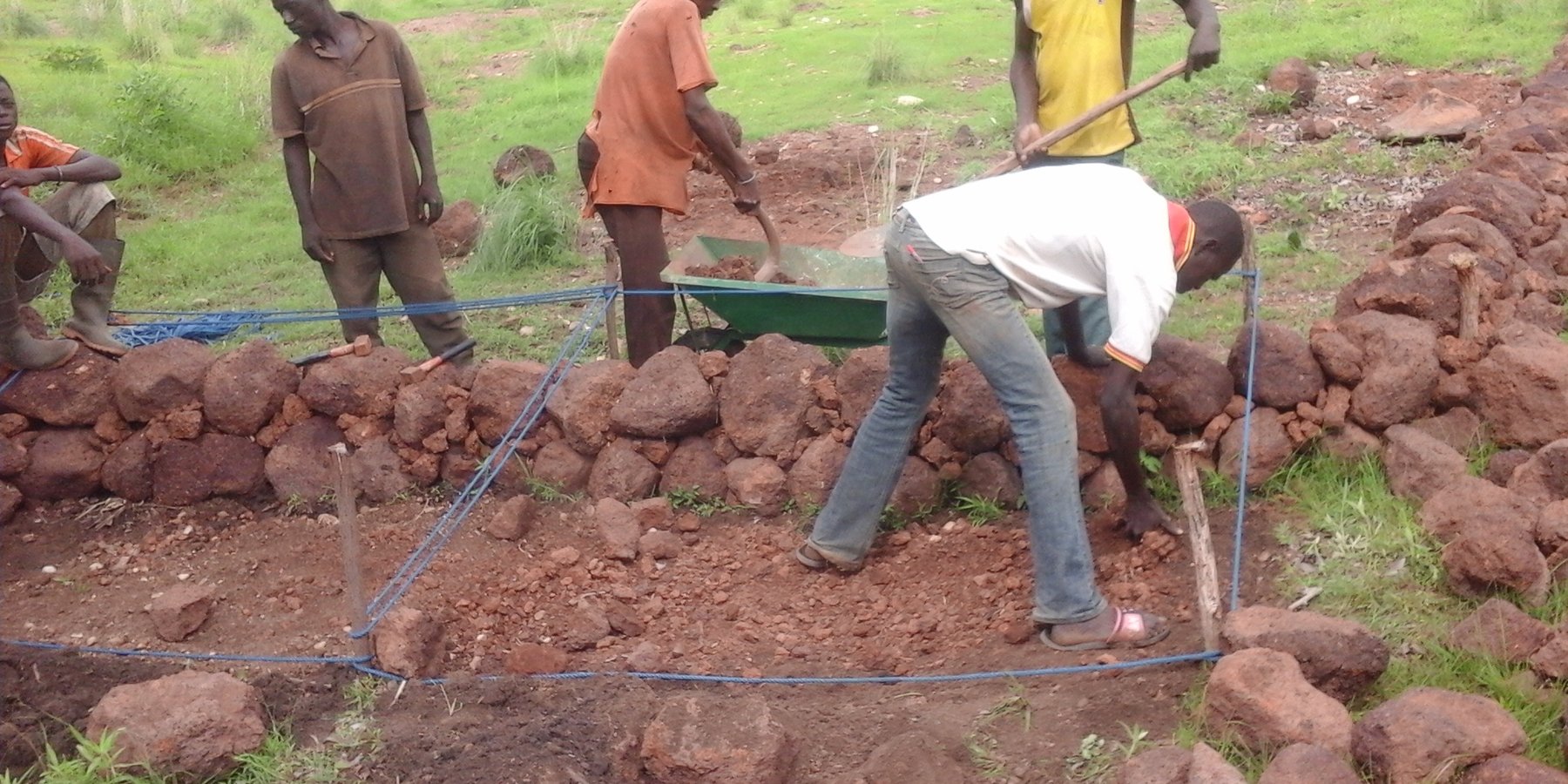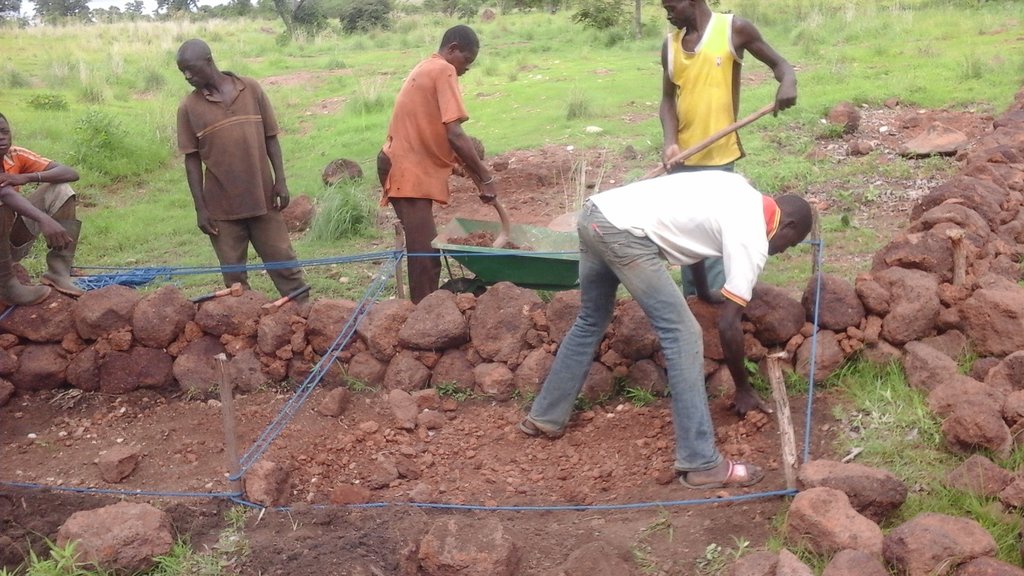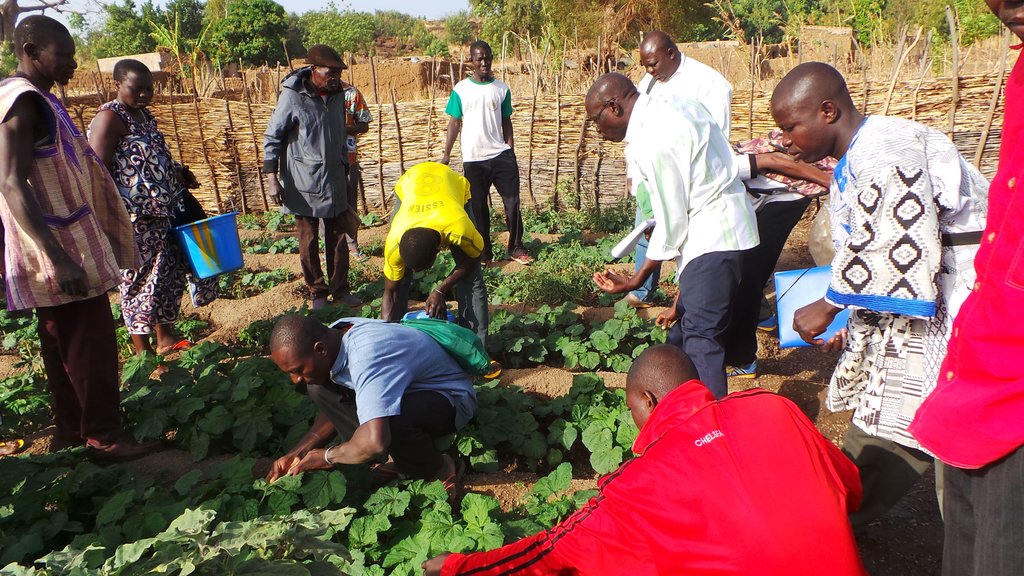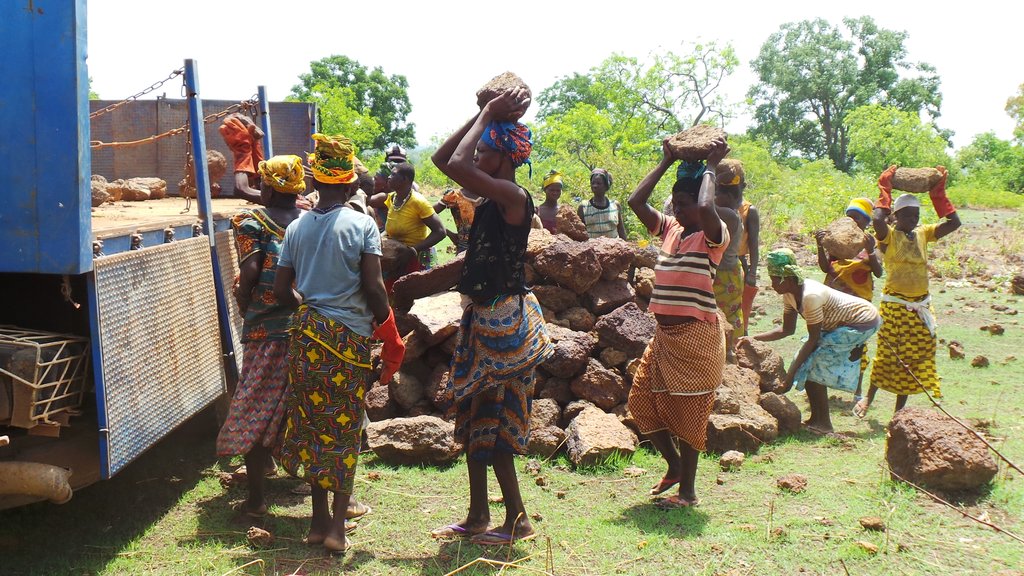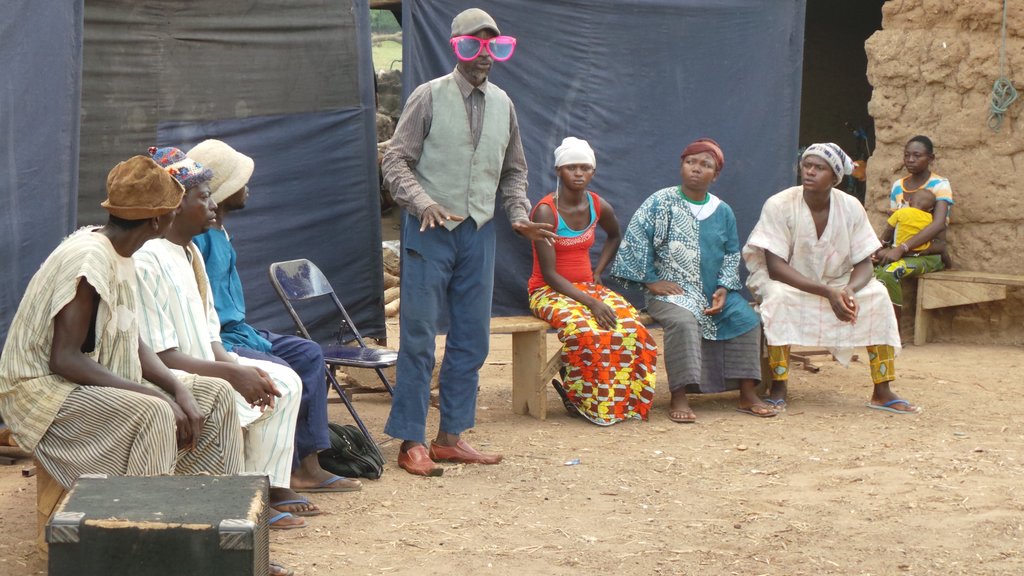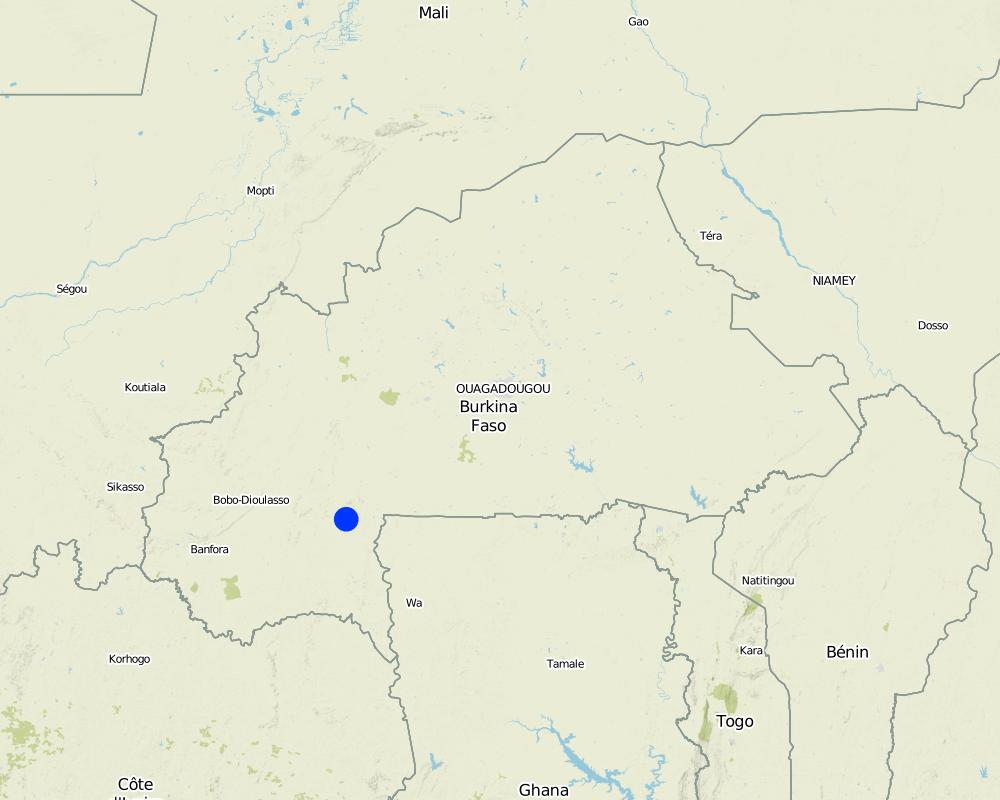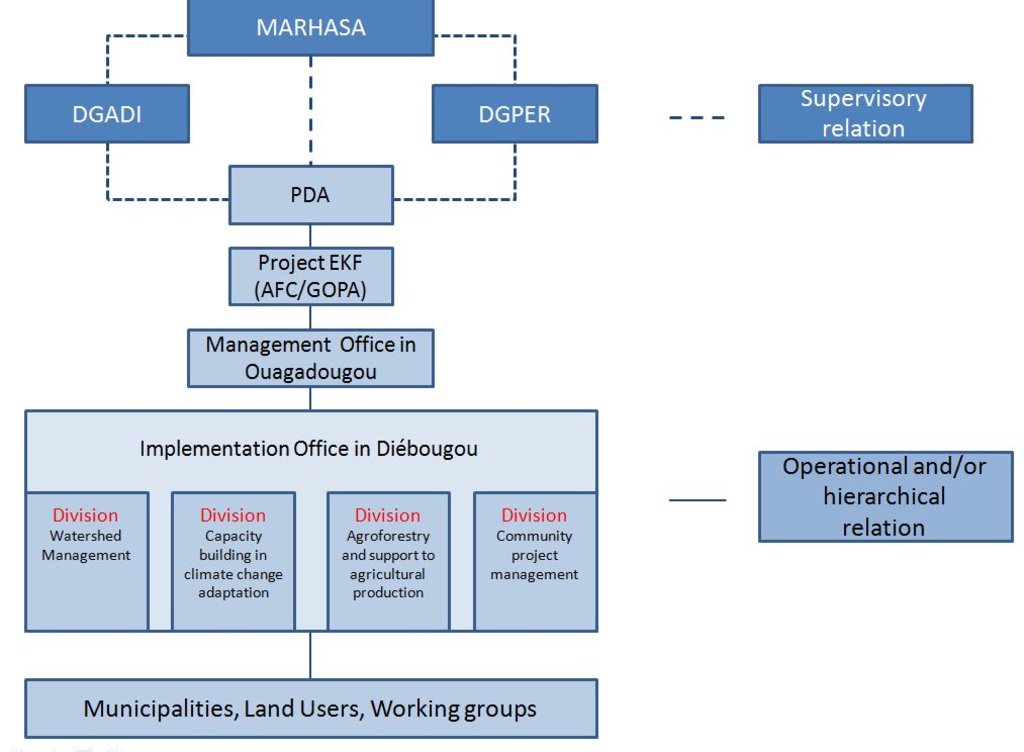Combating erosion, recovery and enhancement of degraded land and climate change adaptation (EKF Project) [Burkina Faso]
- Creation:
- Update:
- Compiler: Rebecka Ridder
- Editor: –
- Reviewers: Nina Lauterburg, Alexandra Gavilano, Deborah Niggli
approaches_608 - Burkina Faso
- Full summary as PDF
- Full summary as PDF for print
- Full summary in the browser
- Full summary (unformatted)
- Combating erosion, recovery and enhancement of degraded land and climate change adaptation (EKF Project): Nov. 16, 2016 (inactive)
- Combating erosion, recovery and enhancement of degraded land and climate change adaptation (EKF Project): Dec. 14, 2016 (inactive)
- Combating erosion, recovery and enhancement of degraded land and climate change adaptation (EKF Project): April 18, 2017 (public)
View sections
Expand all Collapse all1. General information
1.2 Contact details of resource persons and institutions involved in the assessment and documentation of the Approach
Key resource person(s)
SLM specialist:
Poda Novant
Novant.Poda@afci.de
AFC / GOPA
Diébougou
Burkina Faso
SLM specialist:
Kuela Jean Michel
AFC / GOPA
Diébougou
Burkina Faso
SLM specialist:
Cisse Drissa
Drissa.Cisse@afci.de
AFC / GOPA
Diébougou
Burkina Faso
1.3 Conditions regarding the use of data documented through WOCAT
When were the data compiled (in the field)?
20/09/2016
The compiler and key resource person(s) accept the conditions regarding the use of data documented through WOCAT:
Yes
2. Description of the SLM Approach
2.1 Short description of the Approach
The approach applied in this project is an integrated and multi-stakeholder approach in the South West of Burkina Faso, based on watershed management and sustainable land management with a strong emphasis on local participation. It carries out physical and biological measures against erosion, adaptation to climate change and various activities of capacity building.
2.2 Detailed description of the Approach
Detailed description of the Approach:
TThe actions implemented by the project are oriented towards strengthening capacity in adaptation to climate change, communal work, restoration and recovery of degraded land. The specific objectives are:
1) Reduce by 50% the damages caused by extreme weather (heavy rain, drought) on the production bases (soil, water) over a total area of 20.000 hectares
2) Reduce by 30% the period of hunger in 7.500 households
3) Increase by 30% the income of 60.000 farmers, of which 60% are to be women
The areas of work are:
• Watershed Management
In 6 watersheds, the project works towards a recovery of degraded lands through the formation of working groups and the construction of physical structures such as contour stone bunds, rock dams and rock dikes and the treatment gully erosion. Groups for maintaining these constructions are also brought in place. In addition, the project is working awareness raising on issues such as child labour and HIV / AIDS.
• Agroforestry and support of agricultural production
Agricultural production agroforestry is supported by promoting the use of organic manure, improved seeds and the construction of three rainwater collection basins. In addition, this component includes trainings on assisted natural regeneration, controlled land clearing and the fight against bushfires. Demonstration plots are established on various technologies (use of organic fertilizer and pesticides, improved seeds or micro-dose).
• Capacities building for climate change and to strengthen communal work
Climate change, and all its dimensions, should be integrated into municipal planning processes. In addition, the project trains public officials in climate change adaptation.
So far, the project was able to recover 12.709 hectares of degraded land, plant more than 150.000 trees and train more than 80.000 people on climate change.
2.3 Photos of the Approach
2.5 Country/ region/ locations where the Approach has been applied
Country:
Burkina Faso
Region/ State/ Province:
Sud Ouest
Map
×2.6 Dates of initiation and termination of the Approach
Indicate year of initiation:
2013
2.7 Type of Approach
- project/ programme based
2.8 Main aims/ objectives of the Approach
In the southwest of Burkina Faso, population growth and bad practices have led to a sharp deterioration of agricultural land that is enhanced by the effects of climate change. 89% of the local population directly depends on agriculture and the poor ability to adapt to climate change makes them more vulnerable.
Therefore, the project's main objective is to improve the capacities of climate change adaptation. This requires among other things the restoration of 20.000 hectares of land degraded until 2019. This should be achieved through a combination of physical structures, such as the realization of anti-erosion measures and biological measures such as revegetation and promoting agroforestry. These actions are accompanied by capacity building activities on agricultural practices, adaptation to climate change and transfer of knowledge through service providers for the benefit of municipalities and households.
The most important practices:
• Soil stabilization with stone barriers and revegetation using native species
• Conservation of water and soil by promoting agroforestry, the use of manure pits for composting, improved seeds, application of micro dosing, assisted natural regeneration (ANR) and the production and application of bio-pesticides. In all these areas, land users are trained. Special emphasis is put on increasing household incomes and promoting agricultural entrepreneurship.
• Many of the activities aim at the inclusion of women to increase their farm income.
• Rainwater collection techniques through rainwater harvesting and micro dosing (so far, the project has installed three rainwater collection basins with micro-dosing technologies.
• Production of Moringa and promotion of Agroforestry
• And finally, the large-scale awareness. More than 80.000 people have been sensitized on cross-cutting issues such as climate change, HIV / AIDS, child labour and gender through the Forum Theatre.
2.9 Conditions enabling or hindering implementation of the Technology/ Technologies applied under the Approach
social/ cultural/ religious norms and values
- enabling
The local population is open to innvation.
availability/ access to financial resources and services
- hindering
Lack of capital hinders land users to invest in agriculture. Group work must be encouraged.
institutional setting
- enabling
The partnership with the municipalities enables community mobilisation.
The partnership with technical advisory staff (in agriculture and environment) is essential for the follow-up of the construction and for offering extension services to land users.
collaboration/ coordination of actors
- enabling
Municipal staff and customary leaders like the land chiefs are collaborating with the project.
legal framework (land tenure, land and water use rights)
- enabling
Land management is always granted to the land owner after the construction of the anti-erosion works which help to increase their willingness to participate.
policies
- enabling
Climate change adaptation is a priority to the Burkinabe State (Existence of a national adaptation strategy)
knowledge about SLM, access to technical support
- hindering
Lack of knowledge about sustainable land management.
markets (to purchase inputs, sell products) and prices
- hindering
Agricultural inputs (fertilizer etc.) are often unavailable or too expensive.
workload, availability of manpower
- enabling
Work force in general is available.
- hindering
Work loads are high, especially for the building of anti-erosion works.
3. Participation and roles of stakeholders involved
3.1 Stakeholders involved in the Approach and their roles
- local land users/ local communities
Land users, farmer organisations, municipalities (Dano, Dissin, Guéguéré, Koper, Legmoin et Oronkua)
They form the working groups and carry out the construction of the physical structures as well as the planting of trees.
- community-based organizations
Boards of village development
Community mobilisation
- SLM specialists/ agricultural advisers
DGADI (Direction Générale des Aménagements et du Développement de l'Irrigation)
Regional boards of environment and agriculture
Advisory support to the project
Technical evaluation for the project and extension for land users
- researchers
Research institutions contribute with data, especially on soils
- teachers/ school children/ students
CAP Matourkou (Centre Agricole Polyvalent de Matourkou) and students towards the end of their degrees
Evaluation of socio-economic effects and data collection as part of internships/theses
- NGO
Dreyer Foundation
Promotion of agroforestery and Moringa Oleifera
- private sector
Tree nurseries
Transporters
Local tree nurseries and transporters are invited to participate in the project for the transport of stones and for the production of agroforestery plants
- local government
High Commissioner and prefecture
The municipalities
Organisation of meetings
- national government (planners, decision-makers)
Ministry of Agriculture
Umbrella organisation of project
- international organization
WASCAL (West African Science Service Center on Climate Change and Adapted Land Use)
Provision of meteorological data
3.2 Involvement of local land users/ local communities in the different phases of the Approach
| Involvement of local land users/ local communities | Specify who was involved and describe activities | |
|---|---|---|
| initiation/ motivation | interactive | Municipalities, land chiefs and village developpement committees : community mobilisation |
| planning | interactive | Working groups : establish campaign objectives; Municipalities: funding requests and granting of local subsidies |
| implementation | external support | Working groups: construction of anti-erosion measures and planting of trees |
| monitoring/ evaluation | interactive | Working groups: technical inspection of anti-erosion measures; Municipalities: official approval |
3.3 Flow chart (if available)
Description:
The project is implemented by the "Agricultural Development Programme (PDA)" of the German Corporation for International Cooperation (GIZ) GmbH and executed by AFC Consulting International for the period 2013 to 2019. It is funded by the German Fund for Energy and Climate (EKF) on behalf of the Federal Ministry for Economic Cooperation and Development (BMZ). Collaborative protocols exist for the implementation and monitoring of certain activities between the Regional Directorate of Agriculture, the Regional Directorate of Environment and the EKF project. The municipalities are the project partners of the project "Combating erosion, recovery and enhancement of degraded land and climate change adaptation" (EKF).
Several international, regional and local actors are involved in this project. They are:
• MARHASA
The Ministry of Agriculture, Water Resources, Sanitation and Food Safety (MARHASA) provides technical supervision primarily through the General Directorate of Landscaping and Irrigation (DGADI) and the General Directorate General of promoting the Rural Economy (DGPER).
• PDA
The EKF project is part of Component 2 of the PDA (Programme of Development in Agriculture), implemented by the German Cooperation. The PDA has set up a monitoring and evaluation mechanism for the monitoring of project activities, of indicators and results and budget, and for assessing the project's impact at household and public level.
• AFC-GOPA
AFC-GOPA implements the project on behalf of GIZ. It has set up a management team based in Ouagadougou and an implementation team based in Diébougou, with four components: Watershed Management, Capacity Building in climate change adaptation, Support of communcal work and Agroforestry and support of agricultural production.
• The municipalities
The municipalities are the partners of the project.
3.4 Decision-making on the selection of SLM Technology/ Technologies
Specify who decided on the selection of the Technology/ Technologies to be implemented:
- mainly SLM specialists, following consultation with land users
Explain:
Consensus, discussions in work shops at village level
Specify on what basis decisions were made:
- research findings
- personal experience and opinions (undocumented)
4. Technical support, capacity building, and knowledge management
4.1 Capacity building/ training
Was training provided to land users/ other stakeholders?
Yes
Specify who was trained:
- land users
- field staff/ advisers
Form of training:
- on-the-job
- farmer-to-farmer
- demonstration areas
- public meetings
Subjects covered:
- Construction of the anti erosion measures (stone bunds, dams and dikes, gully erosion and composting)
- Agroforestery
- Plant production in tree nurseries
- Agricultural use of meteorological data
- Production of improved seeds
- Production and use of plant-based pesticides / herbicides
Comments:
In order to develop a local knowledge base, 1.770 land users have been trained and educated in the construction of anti-erosion measures, 360 in agroforestery, 20 in the production of trees in tree nurseries , 30 in the use of meteorological data in agriculture, 90 in the production of impoved seeds and 48 in the production of plant-based pesticides.
4.2 Advisory service
Do land users have access to an advisory service?
Yes
Specify whether advisory service is provided:
- on land users' fields
Describe/ comments:
Assistance is offered on different construction techniques for anti-erosive structures. Other subjects are:
• Capacity-building and awareness-raising on climate change and SLM
• Assistance on Assisted Natural Regeneration, Control of Bush Fires
• Assistance and training of farmers on the production of organic fertilizers and improved seeds
4.3 Institution strengthening (organizational development)
Have institutions been established or strengthened through the Approach?
- yes, moderately
Specify the level(s) at which institutions have been strengthened or established:
- local
Describe institution, roles and responsibilities, members, etc.
- Municipalities: Capacity building with regard to community work in climate change adaptation
- Working groups: Groups carry out the collection of material for the stone rows and the construction of these measures, as well as planting the trees. Groups receive a training prior to these activities.
Specify type of support:
- financial
- capacity building/ training
- equipment
4.4 Monitoring and evaluation
Is monitoring and evaluation part of the Approach?
Yes
Comments:
Monitoring and Evaluation is guaranteed through GIZ procedures and methods.
If yes, is this documentation intended to be used for monitoring and evaluation?
No
4.5 Research
Was research part of the Approach?
Yes
Specify topics:
- sociology
- economics / marketing
- ecology
- technology
Give further details and indicate who did the research:
Students towards the end of their studies can write their final papers about the project. The topics are broad and include, for example: An evaluation of the adaptation measures to climate change, an assessment of of agroforestry to climate change mitigation, an assessment of project activities on soil fertility and agricultural production and a study on village and communal forests in the south-west region.
The results of this study show that:
- the majority of land users operate on small areas between 0.5 and 6 hectares;
- agricultural land is degraded and the land pressure is very high over much of the northern part of the region;
- the main cause of land degradation is water erosion combined with poor agricultural practices;
- Sustainable land management practices are developed locally: direct seeding with little tillage, crop association, crop rotation, stone lines, use of organic fertilizer, planting of trees.
- The projetc's operating costs on one hectare of formerly degraded land are F CFA156,000, i.e. € 238;
• The additional average yield generated by the project is 194.4 kg / ha for maize;
5. Financing and external material support
5.1 Annual budget for the SLM component of the Approach
If precise annual budget is not known, indicate range:
- 100,000-1,000,000
Comments (e.g. main sources of funding/ major donors):
The project funds come from the German Cooperation.
5.2 Financial/ material support provided to land users
Did land users receive financial/ material support for implementing the Technology/ Technologies?
Yes
If yes, specify type(s) of support, conditions, and provider(s):
The members of the working group are equipped and paid for their work. The producers of organic manure are equipped to realize their tasks.
5.3 Subsidies for specific inputs (including labour)
- labour
| To which extent | Specify subsidies |
|---|---|
| fully financed |
- equipment
| Specify which inputs were subsidised | To which extent | Specify subsidies |
|---|---|---|
| machinery | fully financed | The project incurs the costs for machinery and the construction of structural measures as well as transportation costs. |
| tools | fully financed | |
- agricultural
| Specify which inputs were subsidised | To which extent | Specify subsidies |
|---|---|---|
| seeds | fully financed | Seeds and seedlings are paid for by the project initially. Acteurs learn how to self-propagate seeds and seedlings. |
- construction
| Specify which inputs were subsidised | To which extent | Specify subsidies |
|---|---|---|
| stone | fully financed | |
If labour by land users was a substantial input, was it:
- paid in cash
5.4 Credit
Was credit provided under the Approach for SLM activities?
No
5.5 Other incentives or instruments
Were other incentives or instruments used to promote implementation of SLM Technologies?
No
6. Impact analysis and concluding statements
6.1 Impacts of the Approach
Did the Approach help land users to implement and maintain SLM Technologies?
- No
- Yes, little
- Yes, moderately
- Yes, greatly
The project has helped strengthen the capacities of municipalities through trainings on municipal project management (in relation to sustainable land management and climate change), trainings of working group members and of agricultural extension agents and through the forum theaters.
Did the Approach improve knowledge and capacities of land users to implement SLM?
- No
- Yes, little
- Yes, moderately
- Yes, greatly
Sustainable land management and its respective activities will be continued even when the project is finished, as working groups are trained and respective policies are disseminated on community level. Groups of land users for maintaining the structural measures are put into place.
Did the Approach improve knowledge and capacities of other stakeholders?
- No
- Yes, little
- Yes, moderately
- Yes, greatly
Municipal staff carries out the tasks to ensure the maintance of the structural measures.
Municipalities work together with extension services. After training, the municipal staff can integrate aspects of sustainable land management in their budget and planning.
Did the Approach lead to improved food security/ improved nutrition?
- No
- Yes, little
- Yes, moderately
- Yes, greatly
Additional agricultural production covers the nutritional needs of 12.451 persons (7.41% of the population in the intervention zone and 2% of the population in Burkina's South East). This will reduce the hunger period by 26 days in the six municipalities (or by 7 days on national scale) and reduce state imports by 283.901.760 F CFA.
6.2 Main motivation of land users to implement SLM
- increased production
The project's activities increase the agricultural area as well as yield/ha of up to 81%.
- reduced land degradation
The implementation of structural, vegetative and agronomic measures leads to a reduction of land degradation. Sediments can be observed along the structures. Certain species that indicate increased soil fertility have appeared, such as Andropogon and Commelina benghalensis. In addition, formerly abandoned land is now used by land users and higher overall yields are obtained.
- payments/ subsidies
The members of the working groups use their income from the activities for:
- purchasing food inthe hunger periods
- clothes
- paying school fees
- pay for agricultural equipment
- medical payments
- housing
- enhanced SLM knowledge and skills
6.3 Sustainability of Approach activities
Can the land users sustain what has been implemented through the Approach (without external support)?
- yes
If yes, describe how:
The activities aim to create a local knowledge system. The anti-erosion measures (physical structures and planted trees) and other climate change adaptation measures can be put in place individually. Furthermore, the provided materiel ensures independent follow ups and maintenance works.
A follow up on municipal level is achieved through the training of public and private personnel in terms of climate change, adaptation strategies and communal work.
6.4 Strengths/ advantages of the Approach
| Strengths/ advantages/ opportunities in the land user’s view |
|---|
| Improvement of agricultural extension and contact to extension services |
| Decrease of land degradation / land loss |
| Increase in agricultural yields |
| Strengths/ advantages/ opportunities in the compiler’s or other key resource person’s view |
|---|
| The project improves, in general, the food security of rural populations, it adapts the local food system to climate change and it mitigates greenhouse gas emissions. |
| Genuine community participation is achieved with this approach. The participatory approach takes into account the needs, views and expertise of the land user. The approach can be adapted to current state of land degradation |
| Awareness raising for environmental issues and the importance of sustainable land management among the local population. |
| The approach may positively influence migration patterns. |
6.5 Weaknesses/ disadvantages of the Approach and ways of overcoming them
| Weaknesses/ disadvantages/ risks in the compiler’s or other key resource person’s view | How can they be overcome? |
|---|---|
| Reproduction of the approach is difficult, when the material (especially stones) is unavailable. | Involvement of extension services at village and regional level to replicate the technology in everyday life |
7. References and links
7.1 Methods/ sources of information
- field visits, field surveys
- interviews with land users
- interviews with SLM specialists/ experts
- compilation from reports and other existing documentation
Links and modules
Expand all Collapse allLinks
No links
Modules
No modules


